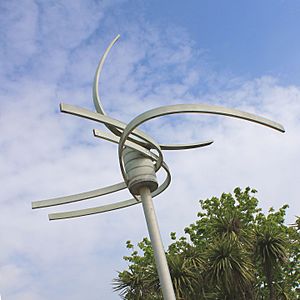Kenneth Martin facts for kids
Kenneth Laurence Martin (born April 13, 1905, died November 18, 1984) was an important English artist. He was both a painter and a sculptor. With his wife, Mary Martin, and another artist named Victor Pasmore, he helped bring back a style of art called Constructivism. This art style focuses on abstract shapes and structures.
Contents
Early Life and Education
Kenneth Martin was born in Sheffield, England. His father worked as a coal clerk. He supported Kenneth's early art studies. Kenneth went to the Sheffield School of Art from 1921 to 1923.
After his father passed away, Kenneth worked as a graphic designer. He continued to study art part-time. In 1929, he won a scholarship. This allowed him to study at the Royal College of Art. There, he met Mary Balmford, who was also an artist. They got married in 1930.
From Naturalism to Abstract Art
In the 1930s, Kenneth Martin painted in a naturalistic style. This means his art looked very realistic. He was part of a group called the Euston Road School. Victor Pasmore was also in this group.
By the 1940s, Martin's art started to change. He began to focus more on shapes and design. Around 1948, his work became completely abstract. Abstract art does not try to show things as they look in real life. Instead, it uses shapes, colors, and lines to create feelings or ideas.
Teaching and Exhibitions
Kenneth Martin also shared his knowledge by teaching art. From 1946 to 1951, he taught at St John's Wood Art School. After that, he was a visiting teacher at Goldsmith's School of Art until 1968.
In 1951, Kenneth and Mary Martin created a publication called Broadsheet. It was all about abstract art. It showed their artworks and explained their new artistic ideas. They wrote more essays over the years. These were published in art magazines.
Public Art and Recognition
Kenneth Martin received many important art commissions. His first sculpture for a public space was "Twin Screws" in 1961. It was made for a big meeting of architects in London. Other public art projects followed.
His work was shown in many major exhibitions around the world. These included the San Marino Biennale and the Tokyo Biennale. His art was also part of important surveys of modern art. These included "This is Tomorrow" and "British Constructivist Art."
Kenneth Martin received several honors for his work. In 1965, he won a gold medal at an international art congress. He was also awarded the OBE in 1971. This is a special honor from the British government. In 1976, he received an honorary doctorate from the Royal College of Art.
Artistic Style and Key Works
After World War II, many British artists moved towards abstract art. Kenneth Martin was one of the leaders in this movement. He believed that abstract painting was a creative process. It was not just simplifying things from nature.
Martin explained that his art was "constructed" using scientific or mathematical ideas. Because of this, he and Mary started making reliefs and moving sculptures. They called these "constructionist" works. They were linked to an earlier art movement called Constructivism.
Sculptures and Movement
One of Kenneth Martin's famous works is "Screwmobile" from 1953. It has brass strips arranged in a spiral shape. This sculpture shows his focus on movement and structure.
He also created static sculptures that still seemed to have movement. Examples include "Oscillation" at the Whitworth Art Gallery. Another was the large "Construction in Aluminium" at Cambridge University. Both were made in 1967. Martin believed that the process of building a work defined its character. He felt that practical steps could lead to imaginative art.
Later, he developed adjustable sculptures like "Rotary Rings" (1968). He also made motorized works such as the "Kinetic Monument" (1977). This sculpture had curved, narrow blades that moved.
Chance and Order Series
After 1969, Martin started a new series of drawings and prints. He called it the Chance and Order series. In these works, he used chance to create art. For example, he would number points on a grid. Then, he would pick numbers randomly. He would draw a line between each pair of numbers he picked.
By changing how he drew the lines or the type of grid, he could create many different drawings. This series explored how random choices could lead to organized and interesting art.
Joint Exhibitions
In 2007, the Tate St Ives museum held a special exhibition. It showed the artworks of both Kenneth and Mary Martin. This was their first joint public exhibition since 1971. The exhibition focused on Kenneth's moving sculptures and his Chance and Order series. It also helped restore his 1955 sculpture, "Mobile Reflector." This artwork was a tribute to another famous artist, Alexander Calder.


